#and yeah not to point a finger at a certain problematic creator that kinda ruined it a lil towards the end
Note
ack the stuff you said about dsmp and its ending and stuff—i feel that. its like this painful nostalgia of what the thing used to be and the fact that it’ll never happen again… i get nostalgic over the lmanburg anthem lmao. im still having a hard time getting over it ahaha.
i honestly hate the ending but i suppose it had to end sometime. Season 2 getting canceled… like you said, there is some comfort in that, but at the same time its so sad to think that it’s finally, officially over. two years of watching funny block men play the funny block game. it was so fun.
is feeling this way over a silly minecraft server overreacting? maybe. but nonetheless theres still that sadness. i just pretend theres a real ending where the nuke doesnt blow everyone up and these amazing characters ive grown to love just live on in their happy little lives.
anyway just wanted to say this after seeing your recent post. in all honesty, i miss dsmp. but seeing that someone i look up to feels the same way i do makes it a little bit easier to bear, i think. so thank you./gen
Hello anon!!! I'm glad I was able to make you feel comforted and better with just a silly Tumblr post (which also was a bit of a rant haha)
Yeah, it's a painful kind of nostalgia. Which is a bit bitter (due to the nature of how ...the dsmp sorta had a very, rather than ending with a big bang, it was more sorta drawn out thin and had a more than unsatisfying ending. its okay,I think as a fandom we are all making our own au endings to replace that one haha)
And despite all the hardship around this dumb lil server, I don't think I regret getting into it. And I still teasure the story and characters so dearly.
I think you're aloud to have such strong feelings over a silly lil thing, cos I think we're past the point of thinking it is dumb to be so invested in a Minecraft server. It was so fucking cool, and not just the server, the fancontent. I would argue that was the thing that made it so loved and engaging to be a part of. The fan content was unmatched and filled with talent.
People who think it's dumb to have a generally fun time within a fandom and to mourn that when it ends, are boring. Yeah it was a Minecraft rp, but it was also the some of the funnest times I've ever had within a fandom.
The dsmp may have ended but the creativity that made it so great is still here, with the fan content and cc, who will go onto new things and continue to make great things and improve.
And besides the story and characters are still there. It's like putting one of your favourite book on a shelf. You can always revisit the story, maybe take something different from it after time.
And I'm sure there will still be fancontent created from the characters, I know I still plan on drawing and writing stuff.
I can't let go of these characters just yet haha.
It's just now there's room for more things, I don't think anything will replace what the dsmp was,I don't want that.
I guess what I'm saying is I'm excited to see what comes next!!! And I'm thankful for the experience of what the dsmp was.
#asks#dsmp#and my feelings towards this silly server#i still love it hhggg#and yeah not to point a finger at a certain problematic creator that kinda ruined it a lil towards the end#im still thankful for the two plus years of story and characters we got#its real bittersweet#damnit ccrimeboys and your grib you have over me#this ask was my excuse to ramble about my feelings on the dsmp haha#im excited to see whats next ...i mean im not that sad#cos ive still got hermitcraft and life series and other things still ongoing#and there's that qsmp that quackity doing that im excited for!!! and even the non Minecraft stuff some of the over cc are doing#like genloss and sorry boys and all that stuff#its exciting :')
26 notes
·
View notes
Text
2019 Mega Drive Explorations [4]
A continuation of parts 1, 2, and 3. Click the link below to read the full post.
The NewZealand Story (1990)
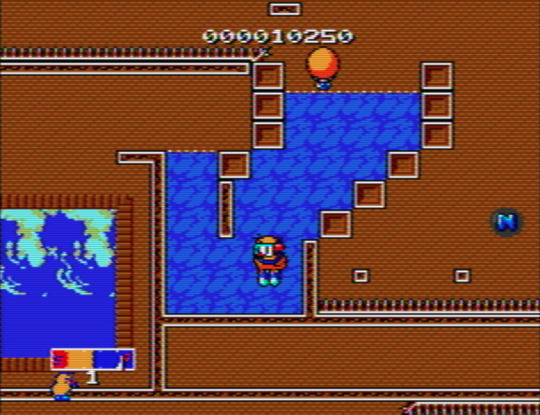

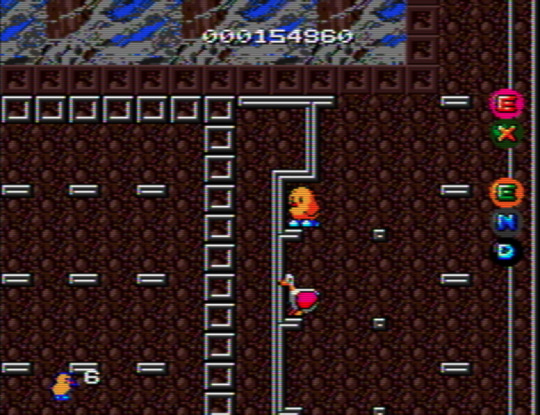
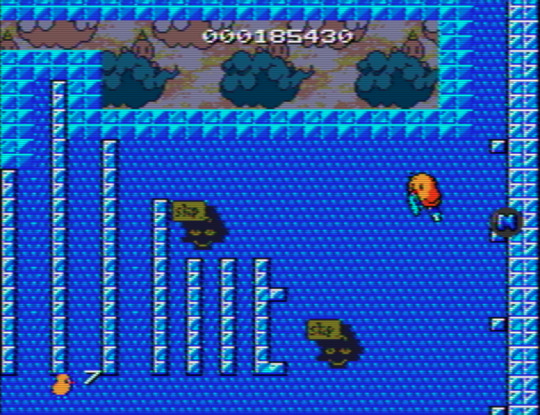
This almost instantly became one of my favorite games for the Mega Drive. It was first an arcade release (1988), and got a ton of ports with, I assume, differences between each; Wikipedia notes that the version I played “had its levels based on the prototype version of the arcade game.” What that means, qualitatively, I’m not yet sure. This is some of the weirdest level design I’ve encountered in a platformer that’s not, like, a reactionary deconstructive work (in the way that the Japanese version of Super Mario Bros. 2 is). The only other somewhat contemporary title I can compare it to is Milon’s Secret Castle (1986). Each of The NewZealand Story’s stages is a sort of maze that’s completed when you reach a fellow kiwi and release them from a cage. What really lets the layouts grow as they do is that, once you get to the second zone (of four), you need to start making use of the various flotation devices which preexist here and there or are left behind by enemies you defeat. So the level design gets to, in a kind of freeform way, flip between “normally” accessible paths and platforms, and toothy stretches demanding aerial navigation. The flotation devices are distinct from one another, too, from how you adhere to it to the speed. What was especially fun about this to me is how, following a clear-out of enemies, you might have a selection of these devices to choose from, and there aren’t really comparative downsides between them (the closest you get to that are these things that look like, uh, torpedoes, which are slow, but they’re also the one device that can’t be popped by shooting at it or touching spikes).
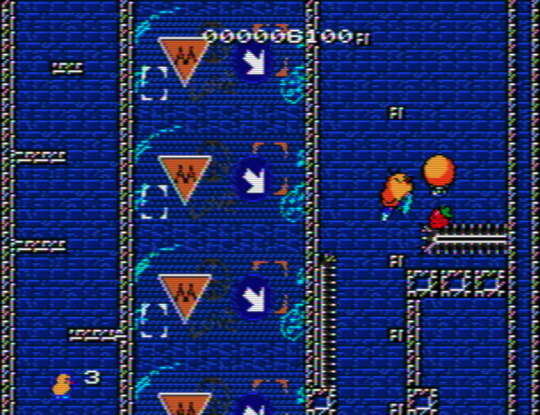


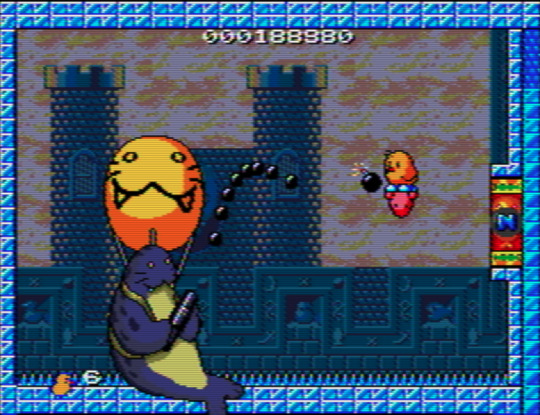
Even if The NewZealand Story isn’t genre-/series-deconstructive, that doesn’t mean it can’t have whimsical moments. A standout for me is illustrated in the third screenshot, where a “room” you have to get to is surrounded by a barrier, and seemingly inaccessible, until you remember that if you are standing below platforms and walkways of a certain thinness and appearance you can jump through them. The solution is to get yourself up against that vertical band and jump through the bit where it briefly horizontally redirects. Cool!! The other thing I like a lot about the level design is that it’s not strictly economical, that some of the structural arrangements seem to exist to form visual patterns more than to control your route. So you have minor casual options for where and how to move through a space. Mercifully, amazingly, bosses are few -- only three -- and they have brevity: you can get rid of the final boss (see the screenshot above) within seconds by popping his balloon. I like looking at this game, too. A couple of stages reminded me of Falcom’s Xanadu and Faxanadu in their cute, flattish, compact representation of architecture or architectural elements within a screen’s worth of space and fortressed tiling. Once you’re past the first zone, loosely themed as a zoo, it’s impossible to tell if the zones’ apertures and voids admit further views or are all mosaics and/or props. It was an unexpected and engaging ambiguity: either interpretation has strange implications. Besides a couple of jumps over and under spikes which demand an inapt exactitude, this is pretty much a perfect game for me, and I wish it had gotten a handheld rerelease on the Nintendo GBA or DS.
Arcus Odyssey (1991)
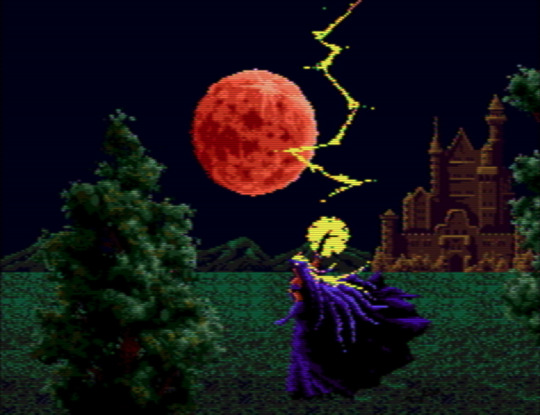



As a Wolf Team-developed game, Arcus Odyssey sits snugly beside Earnest Evans and El Viento as a whirlwind of inexplicable plot points (rendered more inexplicable, and amusing, by an amateurish localization), lopsided pacing, and just a ton of baffling game design that doesn’t really care about you. Everything is exploding and the gravitas has no narrative grounding. It is at its best hilariously joyful and at its worst insensitively prohibitive. Environments, from a network of walkways suspended thousands of feet above the earth, to a colonnaded stepped complex that recalls John Martin’s infernal painting, Pandemonium, are set at an oblique angle and are swimming with sorcerers, skeletons, cockroaches, and other creatures who unendingly come at you from out of nowhere and half of the time spit projectiles. The palettes and narrow, minuscule tilesets give everything the veneer of a PC-98 title. Regardless of the character you choose (for me, it was the pink-haired Erin who wields a whip), the best strategy is to never stop mashing the attack button. This got iffy in one stage where a numerous type of flying creature left behind a crawling string of flames on the ground upon death. The best strategy for bosses? Use an invincibility-granting item you’ve hopefully snagged from a treasure chest, stand right next to the boss, and... yeah, mash that attack button. Which is fine! This is not a game where the mechanics could’ve yielded bosses who were interesting for reasons other than their appearance.


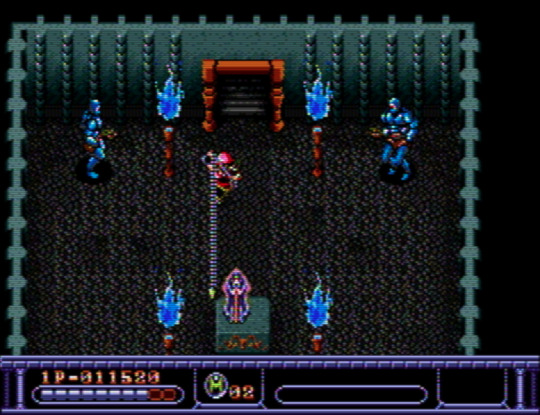
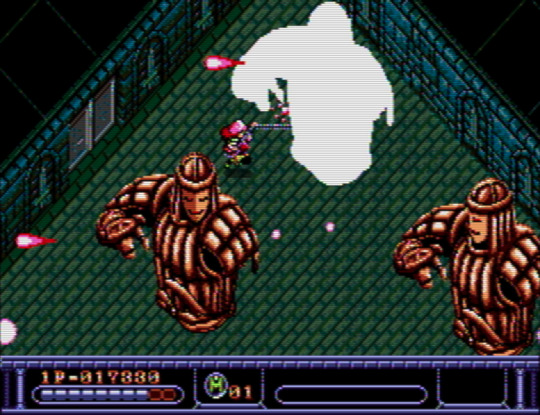
Arcus Odyssey has two serious, debilitating issues, though. The first is that you only have room in an inventory menu for six items (five, really; one of these items is permanent), and yet I have quite literally never seen another videogame with so many treasure chests relative to its stages’ sizes. You’ll mostly be passing stuff up then because you’re at capacity. Sure, you can consume the things you have to make room, but there are at least three items which have contextually valuable uses: the potion of invincibility, the lifebar-refilling lamp of life, and the resurrecting doll of life. Stocking up on one kind to the exclusion of everything else isn’t a sustainable plan. So the “economy,” as it were, is kinda fucked. The second debilitating, perhaps eventually paralyzing, issue is that Arcus Odyssey has the design of an early Japanese PC action-RPG like Ys or Rune Worth, where you are constantly harangued by waves of enemies who non-specifically occupy the level designs and bosses who may instantly unload multiple projectile-based attacks. That sort of design, somewhat haphazard as it was, could function (with degrees of success) in the context of the RPG part of the “action-RPG” equation, since you could reliably and incrementally level up (and save!). Arcus Odyssey doles out a few upgrades here and there, but it plays out like an action game that doesn’t understand the forms it’s borrowing. As such, it’s easy -- and become easier, the further along you are -- to get yourself into situations whose demands for superhuman, verging on omniscient, performance make no sense. Real shame.
Marvel Land (1991)


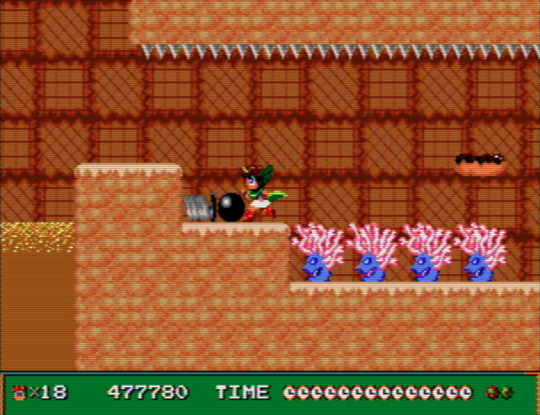
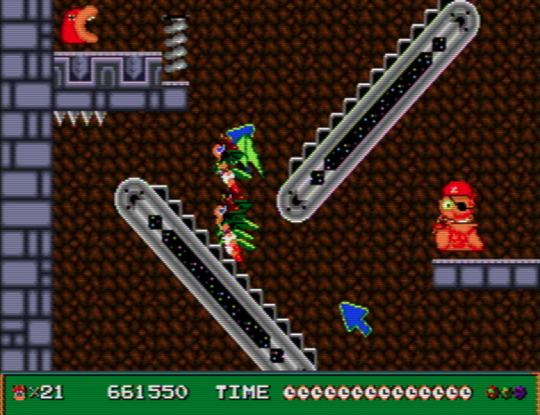
Like The NewZealand Story, Marvel Land is a Mega Drive port of an arcade game released a couple of years earlier. Also like the former, it quickly became a personal console-favorite. A few prickles keep me from fully loving it -- namely, the bizarre precision you need to have when jumping on enemies to not get hit yourself (and a hit here, as per usual with arcade games before the 90s, equals death), a few too many leaps of faith, and optional doorways which can send you back to previous levels, as far as the very first -- but the diversity of creatures, stages’ arrangements and themes, power-ups, and unconventional bosses have an individual and cumulative appeal that outweighs those problematics. I think I’m obligated here to say that I will almost automatically like any videogame that has a candy-themed environment, and Marvel Land has one of those, complete with waddling ice cream cones, gingerbread houses, and a maze built of cracker-cookies. The two main and most interesting power-ups are wings which temporarily give you a much higher jump and the ability to fly, and a string of self-duplicates which can be whipped around to hit enemies, collect items for score, and latch onto targets to swing from them. A later level surprised me when it both expected me to use the wings to progress and to be mindful about the height of my jumps so as to not skewer myself on spikes., denying the expectation that such a liberty would dissolve hard designs.


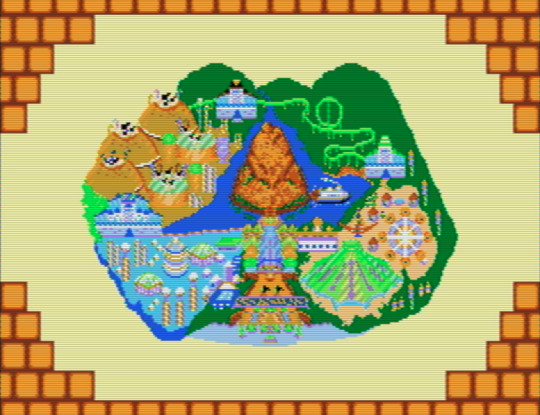

Bosses deserve a special mention because, god, by now I just hate bosses, they ruin so many of these games, and Marvel Land’s are designed as “minigames” -- a game of rock-paper-scissors, selecting an illustration in a grid that matches an example below, or Whac-a-mole (against a mole). It’s decent, clever, and properly playful. Despite this, the game is still compelled to have a “real” boss fight at the very end (were the developers anxious?), and I could’ve done without that; but, it was straightforward enough. The aforementioned bestiary, if you want to call it that, is wonderful and funny and can hold its own against any of the Kirby games’ rosters. You can see, for example, in the last screenshot that a feisty mallard duck who beckons at you with an index feather-finger is named COMEON. Other members include HEAVY, a chubby pink snake, and GIANTBURGER, a sentient burger. As a closing comment, I’ll say that it’s striking and odd how many videogames, from Japan, no less, were about restoring the rule of a Eurocentric fairytale monarchy. Hell, that’s what two of Nintendo’s most popular extant series are about (Super Mario Bros. and The Legend of Zelda). Why is this an international go-to for a premise? And how could anyone care about it? In some cases I think it’s fair to guess that the creator(s) did not care and simply went with a cultural trope that was within grabbing range; but the question remains of why those tropes are within grabbing range. We already know why these narratives are also fiercely heteronormative (even The NewZealand Story has to make the last kiwi you rescue be a girl -- wow, thank god!), but this prevalent medievalism that has an uncritical nostalgia for monarchy kinda mystifies me.
8 notes
·
View notes